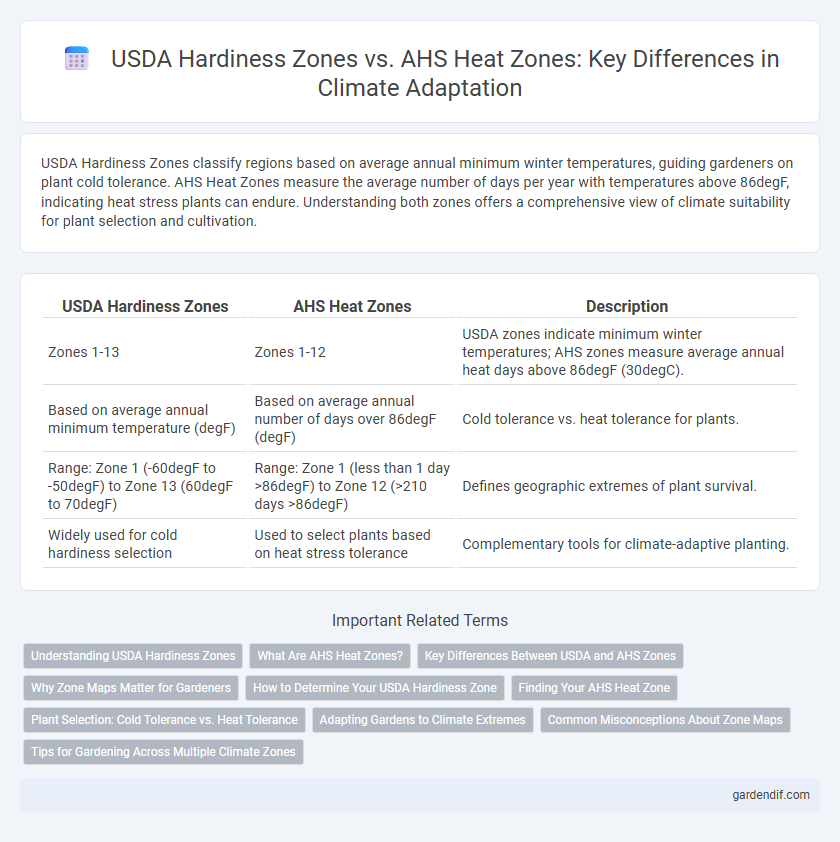
USDA Hardiness Zones vs AHS Heat Zones Illustration
USDA Hardiness Zones classify regions based on average annual minimum winter temperatures, guiding gardeners on plant cold tolerance. AHS Heat Zones measure the average number of days per year with temperatures above 86degF, indicating heat stress plants can endure. Understanding both zones offers a comprehensive view of climate suitability for plant selection and cultivation.
Table of Comparison
| USDA Hardiness Zones | AHS Heat Zones | Description |
|---|---|---|
| Zones 1-13 | Zones 1-12 | USDA zones indicate minimum winter temperatures; AHS zones measure average annual heat days above 86degF (30degC). |
| Based on average annual minimum temperature (degF) | Based on average annual number of days over 86degF (degF) | Cold tolerance vs. heat tolerance for plants. |
| Range: Zone 1 (-60degF to -50degF) to Zone 13 (60degF to 70degF) | Range: Zone 1 (less than 1 day >86degF) to Zone 12 (>210 days >86degF) | Defines geographic extremes of plant survival. |
| Widely used for cold hardiness selection | Used to select plants based on heat stress tolerance | Complementary tools for climate-adaptive planting. |
Understanding USDA Hardiness Zones
USDA Hardiness Zones categorize regions based on the average annual minimum winter temperature, guiding gardeners in selecting plants that can survive cold conditions. These zones range from 1 (coldest) to 13 (warmest), providing critical data for frost tolerance and plant survival rates. Understanding USDA Hardiness Zones enables accurate prediction of plant resilience, ensuring optimal growth and reducing loss in colder climates.
What Are AHS Heat Zones?
AHS Heat Zones classify regions based on the average number of days per year with temperatures exceeding 86degF (30degC), which is critical for understanding plant heat tolerance. Unlike USDA Hardiness Zones that measure cold tolerance through minimum winter temperatures, AHS Heat Zones provide insights into the intensity and duration of heat stress on plants. Gardeners and horticulturists use AHS Heat Zones to select heat-resilient species, ensuring successful growth in warmer climates.
Key Differences Between USDA and AHS Zones
USDA Hardiness Zones categorize regions based on average annual minimum winter temperatures, guiding plant survival in cold climates. AHS Heat Zones measure the average number of days per year that temperatures exceed 86degF, indicating heat tolerance for plants. The key difference lies in USDA Zones emphasizing cold stress, while AHS Zones focus on heat stress, providing complementary data for optimal plant selection.
Why Zone Maps Matter for Gardeners
USDA Hardiness Zones provide essential information about the minimum winter temperatures plants can endure, guiding gardeners in selecting cold-tolerant species. AHS Heat Zones complement this by indicating the average number of days with temperatures above 86degF, critical for assessing heat stress on plants. Together, these zone maps enable gardeners to choose plants that thrive within their specific climate range, optimizing growth and reducing plant stress.
How to Determine Your USDA Hardiness Zone
Determining your USDA Hardiness Zone involves referencing the average annual minimum winter temperature in your region, which is categorized into 13 zones ranging from 1 (coldest) to 13 (warmest). The USDA Plant Hardiness Zone Map, updated in 2012, provides detailed geographic data based on temperature records from 1976 to 2005, allowing gardeners to select plants that can survive local winter conditions. This zone differs from AHS Heat Zones, which measure the average number of days with temperatures above 86degF, highlighting heat tolerance rather than cold hardiness.
Finding Your AHS Heat Zone
Finding your AHS Heat Zone involves identifying the number of days per year that a region experiences temperatures above 86degF (30degC), which impacts plant heat tolerance. Unlike USDA Hardiness Zones that measure cold tolerance by minimum winter temperatures, AHS Heat Zones provide crucial data on summer heat stress, enabling more precise plant selection for warm climates. Access tools like the American Horticultural Society's Heat Zone Map to pinpoint your exact heat zone and optimize garden planning accordingly.
Plant Selection: Cold Tolerance vs. Heat Tolerance
USDA Hardiness Zones provide essential information on cold tolerance by categorizing regions based on minimum winter temperatures, aiding gardeners in selecting plants that can survive freezing conditions. AHS Heat Zones complement this by indicating the average number of days above 86degF, helping in choosing plants with appropriate heat tolerance for warmer climates. Combining both zoning systems ensures optimal plant selection tailored to withstand both cold winters and hot summers, enhancing plant survival and growth.
Adapting Gardens to Climate Extremes
USDA Hardiness Zones classify regions based on average annual minimum winter temperatures, guiding plant selection for cold tolerance, while AHS Heat Zones measure the average number of days above 86degF, indicating heat stress on plants. Combining these zones helps gardeners adapt to climate extremes by selecting species resilient to both cold snaps and prolonged heat. Strategic plant choices and garden designs using USDA and AHS zone data improve survival rates and maintain vibrant landscapes amid climate variability.
Common Misconceptions About Zone Maps
USDA Hardiness Zones and AHS Heat Zones serve different purposes in climate classification: USDA zones indicate minimum winter temperatures suitable for plant survival, while AHS Heat Zones reflect the number of days with temperatures above 86degF, impacting heat tolerance. Many gardeners mistakenly rely solely on USDA zones to assess plant heat resilience, ignoring that heat stress can be critical in plant selection. Understanding both zone maps improves accuracy in predicting plant performance and climate adaptation strategies.
Tips for Gardening Across Multiple Climate Zones
Gardening across USDA Hardiness Zones and AHS Heat Zones requires selecting plants that thrive in both minimum winter temperatures and maximum summer heat. Prioritize choosing heat-tolerant species for AHS zones while ensuring cold-hardiness based on USDA zones to protect plants year-round. Use soil amendments, mulches, and proper watering schedules tailored to the specific climate stressors in each zone to optimize plant health and growth.
USDA Hardiness Zones vs AHS Heat Zones Infographic

 gardendif.com
gardendif.com